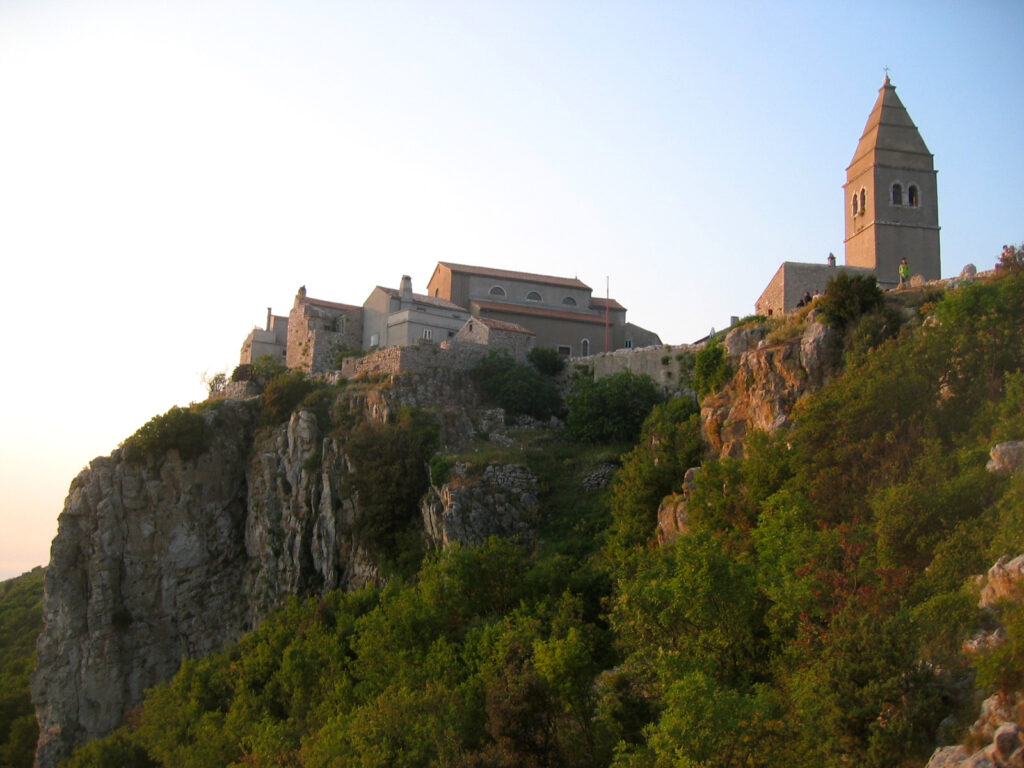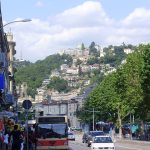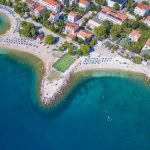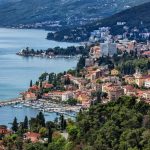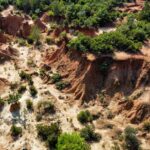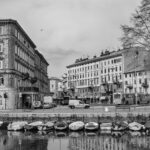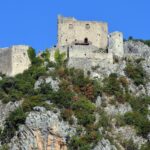Being a somewhat wild and mysterious place, Cres is Croatia’s biggest island, still mostly undiscovered by tourists. Which doesn’t mean that there isn’t plenty to discover.
- Welcome!
- How to get to Cres and get around
- 5 things not to miss
- Where to stay?
- Where to eat?
- Top 3 day trips from Cres
- 5 things you didn’t know about Cres
Welcome
Although the biggest Croatian island (topping the neighbouring Krk by just a couple of square meters), Cres is not a very populated place. It is home to some 3000 people, with the vast majority living in the main town, also called Cres. Most of the island is empty, with hamlets scattered here and there – yet this only adds to its magic. If you’re looking for an out of the ordinary, off the beaten path holiday, Cres is THE PLACE for you. And keep in mind the island’s unofficial slogan: “No stress on Cres!”
How to get to Cres and get around
Plane
Cres’ neighbour island of Lošinj has a small airport – the flights and few and far between, but it’s worth checking out the options. There are buses from Lošinj to Cres, but they are sparse, so best to rent a car or get a private transfer. The closest big airport is Rijeka’s, located on the island of Krk, just next to Cres. From there the best option is to rent a car, as relying on public transport will complicate your life. Another close airport is the one in Pula – continuing by car is the only prudent option.
Ferries and Catamarans
There are two ferry lines connecting Cres to the mainland. The first runs from Valbiska on Krk island (a bridge connects Krk to the mainland) to Merag on Cres. This is the best route if coming from Rijeka, Zagreb, or Dalmatia. The other runs from village Brestova on the east Istrian coast to Porozine on Cres. Be prepared for a narrow, bumpy road from Porozine to Cres town, and watch out for the sheep (more on that later). This is the best option if coming from Istria, Slovenia or Italy.
A daily catamaran line connects Cres town to Rijeka. This is the only option to reach the island by boat, as arriving by other ferry lines requires driving. For the boats’ and ferries timetable, see the Jadrolinija website, or our article with details of how to get around the Adriatic.
Buses, roads
There is a daily bus line from Rijeka, and a bus line from Zagreb a couple of times per week. Check the Arriva website to see all of the options.
It’s highly recommended to rent a car when visiting Cres, as it’s basically the only option to explore the island. As the main attractions are quite remote one from the other, and the place is hilly, biking around is reserved only for the most ambitious.
5 things not to miss in Cres
Lubenice
Easily the most spectacular place on Cres is this tiny town located on a 380 meters high rock on the western part of the island. The place was settled some 4000 years ago and is inhabited ever since. The present town is hundreds of years old and magical enough to be nominated for the UNESCO World Heritage site. The view at Kvarner bay is more than stunning.
If you’re willing to hike a bit, a good idea is to descend to the beaches below the town. Just keep in mind: getting down will be quite easy, but you gotta think about getting back!
Osor
Another amazing town on Cres is Osor, located in the southern part of the island. Osor lies at a narrow channel that now separates the islands Lošinj and Cres. In the past, the two islands were, in fact, just one island. Then, during ancient Roman times, a channel was built, mostly to enable sailing. Before and after the channel came about, Osor was an important port for various rulers. It maintained its importance until the 15th century when the town of Cres became the centre of the island.
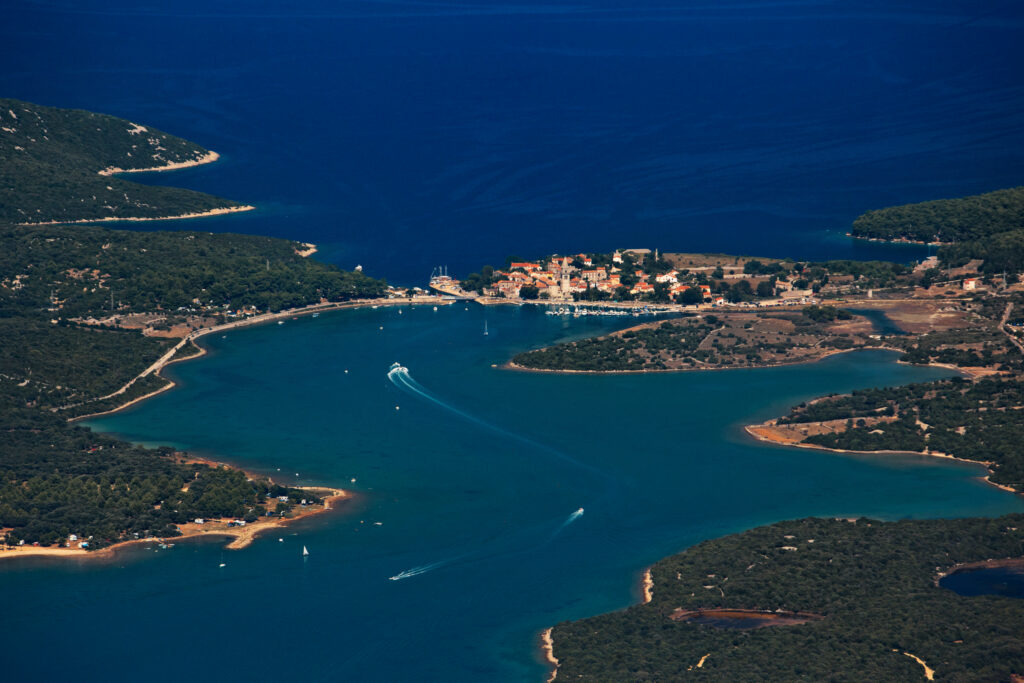
Today it’s almost deserted, with less than a hundred inhabitants. However, it is still preserved like it was in its splendorous times. Apart from the town itself, the main attraction is the Osor Musical Evenings, a classical music festival held from July to August since 1976. Osor also boasts a large collection of public sculptures dedicated to music and musicians, made by famous Croatian artists such as Ivan Meštrović.
Beaches
Surrounded by crystal clear waters, Cres is a place to be for swimming. Keep in mind that getting to some of its best beaches can be a little adventurous, as they are not reachable by car. If you don’t visit on a boat or yacht – which is the best way to explore Cres’ hidden beaches – get ready for a bit of walking. One popular place is beach Meli, located near village Belej, covered in sand, which isn’t common on Croatian beaches. Close to Osor you will find Punta Križa, a peninsula with numerous bays and rich vegetation. More approachable is pebbles-covered Martinšćica, located next to the village of the same name. Mali Bok, next to village Orlec, is easily the most charming beach on the island. Another place worth mentioning is the beach next to Beli, a village on the north.
Food
Pag island might get the credit as the place from where the best lamb comes from, but the one from Cres is just as good. There are some who would die on the hill of Cres lamb being better! Sheep are left to wander freely around the desolate parts of the island, eating aromatic herbs, all of which gives their meat a unique taste. This is the reason to be careful when driving around the island, as flocks or individual sheep on roads are a common sight. Also best not to come near them, as they might get aggressive. (Do not follow the example of the author of the article pictured below.)
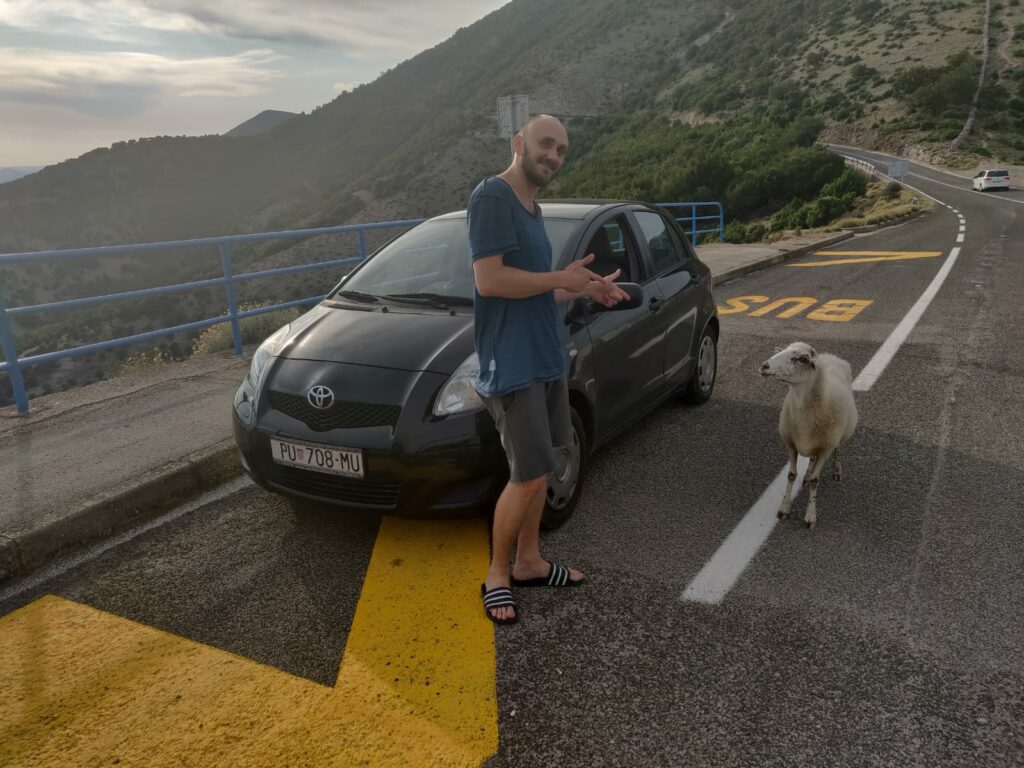
Another unmissable staple on Cres is scampi (or shrimp or prawn). They abound in the Kvarner bay, and their taste is unsurpassable. This shouldn’t come as a surprise, as you can witness fishermen delivering their fresh, still moving catch, to the restaurants, and eat it half an hour later. If eating locally sourced foods is important to you, Cres island will offer you many options.
Tramuntana forest
At the north of the island, close to Beli, we find this centuries-old forest, unique for being broadleaf, as opposed to the evergreen vegetation of the rest of the island. It is intersected by a number of hiking trails. In the forest, you can also find a sculpture park, including labyrinths made of stone. Spectacular views of Istria and the Kvarner bay are included. And don’t forget to look up, as you might see a magnificent bird! (more on that later) For info, see here.
Where to stay in Cres
The only big place on the island is the three-star hotel Kimen in Cres town. If hotels are not your thing, best to look for private rooms, apartments, or guesthouses. The town of Cres offers the most options, with Valun, Martinšćica and Beli being other hubs, while offering more privacy. Camping is also a good idea on Cres – check out Kovacine, next to Cres, Slatina, near Martinišćica, Bijar, next to Osor, or Baldarin, on Punta Križa. The last one is a naturist resort.
Where to eat on Cres
If you want to try lamb, the unmissable place is konoba Bukaleta in Loznati village. They offer all the possible lamb dishes, from grilled chops to tripes. For seafood, best to go to village Valun, where you should check out restaurants Na moru and San Marco. The author of this article also had one of the best pizzas in Croatia in Pizza Napoletana & Grill Porto, located in village Nerezine on Lošinj, just across Cres.
Top 3 day trips from Cres
Lošinj
Cres and its neighbouring Lošinj used to be one island, but nowadays the two are separated by the channel next to Osor, built in Roman times. A bridge connects them so it’s easy to get to Lošinj, whose main town, Mali Lošinj, is the biggest town on the Croatian islands. Its special attraction is the Museum of Apoxyomenos, an ancient Greek sculpture of an athlete found in 1997 in a sunken ship near Lošinj’s coast, an extraordinary and very rare example of a preserved ancient statue. For hiking lovers, a good idea is to climb the Osorščica mountain. See the trail here, and please make sure you’re fully prepared for hiking.
Istria
Both Istria and Cres used to be part of the so-called Julian March region of the Austro-Hungarian Empire, with a predominantly Italian-speaking population. It also included Trieste, Gorizia, Veneto and Friuli. Although the area is now divided between Italy, Slovenia and Croatia, some shared heritage is still obvious. Istria makes for a great one-day trip from Cres – you will need to catch the ferry from Porozine to Brestova, and drive to your chosen Istrian destination. The closest place worth visiting is Labin, east Istria’s biggest town, less than half an hour away from Porozine. Other popular Istrian places – Pula, Motovun, Rovinj – are about one hour away from the ferry port.
The Kvarner archipelago
Cres and Lošinj are the biggest islands in Kvarner bay, but there is a number of smaller islands surrounding them. Being quaint places with few inhabitants, they are worth a day trip – check out Unije, Ilovik and Susak. Susak, the biggest one, is particulary interesting, being the only Adriatic island formed of sand. There is a catamaran line connecting Mali Lošinj to all of the aforementioned islands – keep in mind it departs at 6 in the morning.
5 things you didn’t know about Cres
Griffon vulture
This great bird was once widespread in the mountainous parts of Croatia, but nowadays Cres, and a couple of neighbouring islands, are its only remaining home. This is not surprising, as it prefers areas with few humans, but a lot of animals on whose carcasses it feeds – think of all the sheep on Cres!
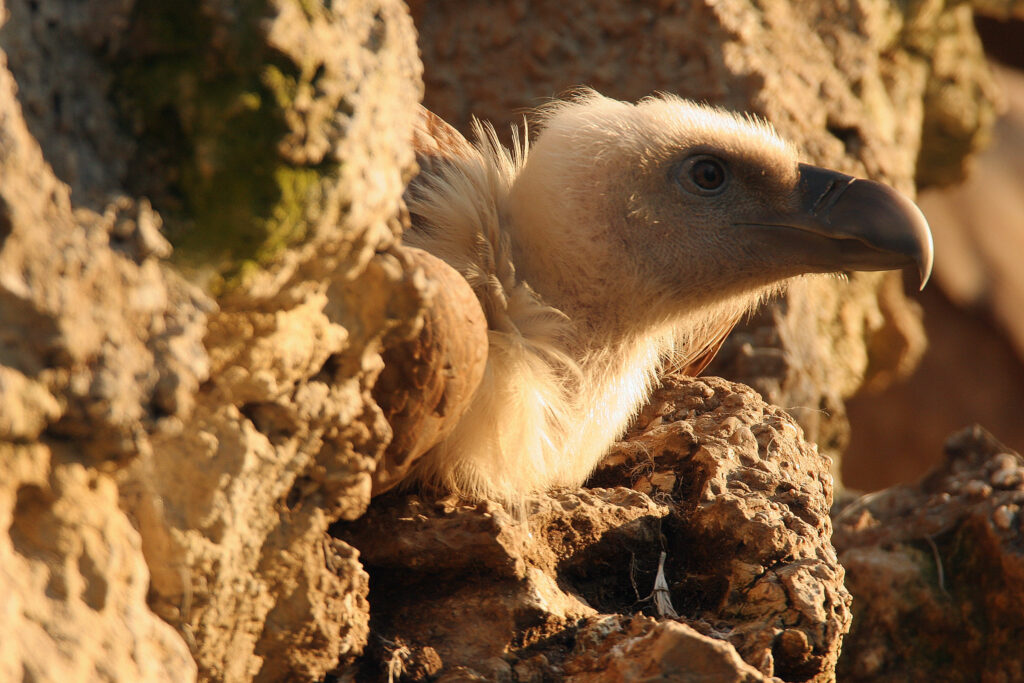
The population, found mostly in the northern part of the island close to Beli and Tramuntana forest, numbers around 100 pairs. This makes it an endangered species, with special care being dedicated to its preservation. In charge of that is Beli Visitor and Rescue Centre for Griffon Vultures – check out their webpage for educational workshops.
Vransko lake
Although Cres is not the only Croatian island with a lake on it, its Vransko jezero is by far the biggest one of them. Although it’s a cryptodepression – meaning the lake’s surface is above the sea level, while its bottom is below it – it’s a freshwater lake. It is over 70 meters deep, which makes it a huge reservoir of drinking water. Vransko lake thus serves as a source for entire populations of Cres and Lošinj islands. The water is so pure it doesn’t need filtering, and to preserve it, any access to the lake is strictly prohibited.
No Snakes!
The Croatian coastal region is home to one of Europe’s most dangerous snakes, the horned viper. However, Cres island is famous for unusually being free of any venomous snakes. This led to legends being told about Cres’s soil having magical properties. Whatever the cause, be not afraid if you end up encountering a snake while walking in nature on Cres – it can’t harm you!
Absyrtides
As mentioned, in ancient times Cres and Lošinj were a single island, and their collective name was Absyrtides. This name originated from the legend of Argonauts. According to it, when Jason and Medea fled her homeland with the golden fleece, she brought her young brother Absyrtus with her. Pursued by her father, she killed her own brother and threw his dismembered corpse into the sea. The heartbroken father returned home, and Absyrtus’ body turned into the islands. The legend also gave a name to Osor (Apsorros).
The Amber Road
Osor sits on the oldest trading route in Europe. Since at least 16 century BC, the route served to bring amber from northern Europe to the Mediterrenean area. The precious commodity found its way from Baltic Sea to as far as Egypt – into Tutankhamen’s breast ornament, for example. Osor used to be one of the first stops on the maritime part of amber’s journey to Aegean Sea and further.
More information
To follow the latest news from Cres, check out the dedicated TCN page.

